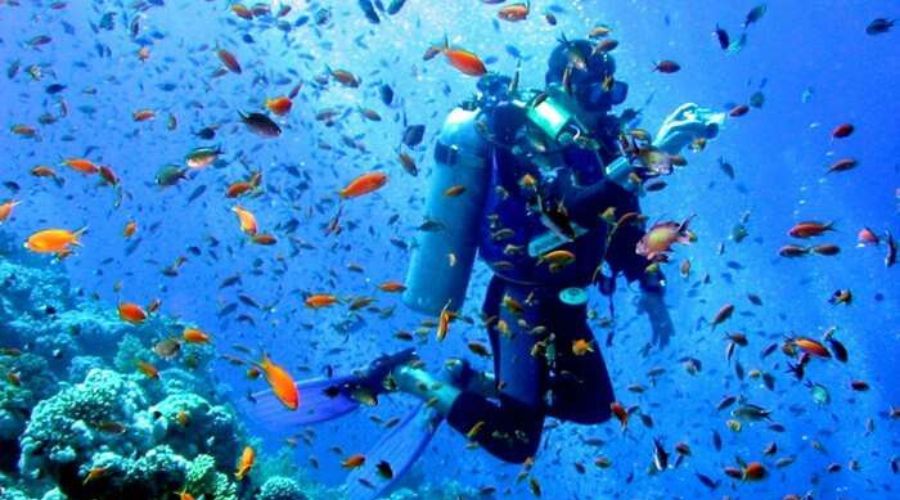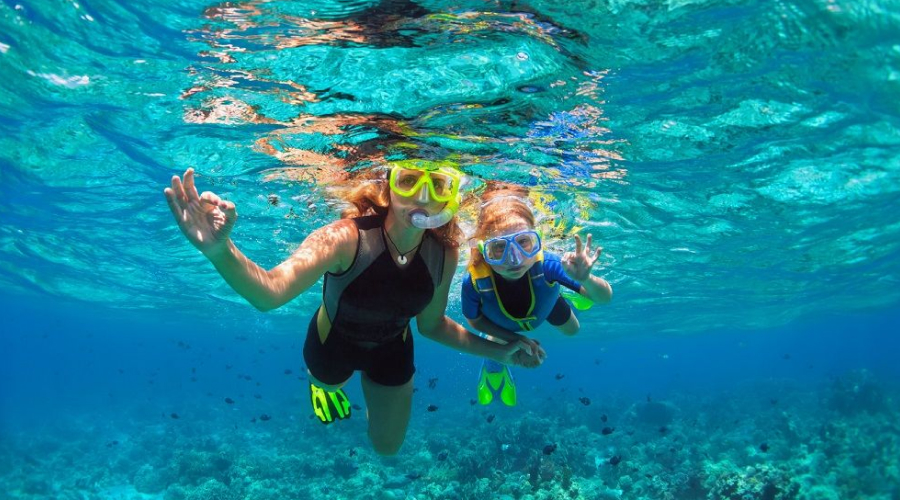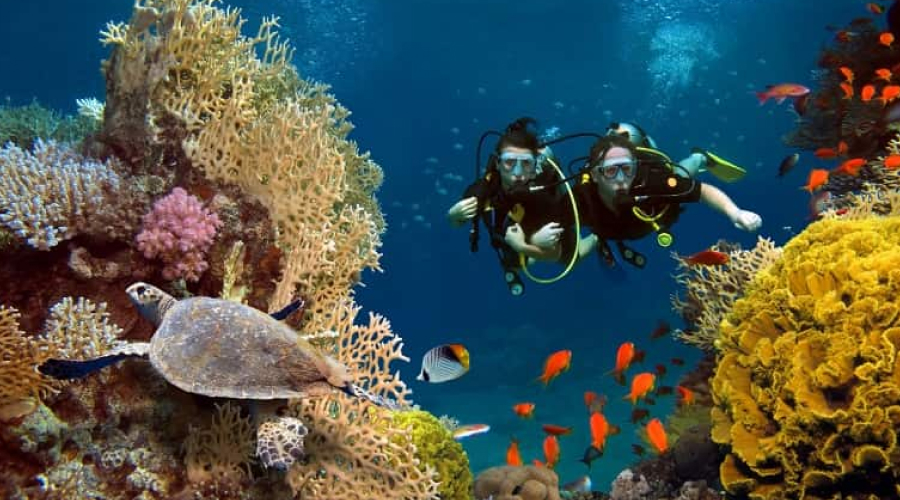Underwater Photography as an Art
Underwater photography is a specialized type of photography that involves capturing images beneath the surface of water. It requires specialized equipment and techniques to deal with the unique challenges of shooting in an aquatic environment. This genre is widely used in documenting marine life, capturing underwater landscapes, or creating artistic images.
Suggested Read: Kayaking in Andaman and Snorkelling in Andaman
The subjects of underwater photography are usually marine creatures like fish, turtles, dolphins and coral reefs. Also, the underwater landscapes, including shipwrecks, caves and sea beds are attractive choices. Human activity, such as divers, swimmers or models posing underwater also make for nice pictures to be carried back as memories by tourists and travellers.
Waterproof cameras or regular cameras in waterproof housings have to be used. The lenses should be optimized for underwater use such as wide-angle and macro lenses are common. Artificial lighting like strobes or underwater flashlights are generally used to deal with light loss and colour distortion. Getting close to the subject to reduce the distortion caused by water is a major technique to get flawless photographs underwater. Using a wide-angle lens for broad scenes and a macro lens for close-up details helps getting nice clicks.
During underwater photography it must be remembered that limited natural light is present as the depth of water increases. Water is also known to absorb red and yellow light, making scenes appear blue-green. Maintaining buoyancy while composing shots is also important for striking photos.
Suggested Read : Andaman tour packages
Among all the types of underwater photography, Andaman is specifically known for wildlife photography. The marine species and their behaviour in their natural habitat make for priceless photography. Wreck photography which documents shipwrecks and underwater ruins are clicked or underwater portraits involving capturing divers, swimmers or models in creative underwater settings are other types. Abstract and artistic photography focuses on patterns, colours and reflections underwater to create abstract art. Scientific photography is used for research purposes, such as documenting coral bleaching or marine biodiversity.
Underwater photography is used for marine research to study aquatic ecosystems and biodiversity and for creating conservation awareness that highlights issues like coral bleaching or plastic pollution. It is also used for advertisements, movies or exhibitions. Scuba divers or snorkelers document their experiences through underwater photography.
Among the most popular locations for underwater photography, the Andaman and Nicobar Islands is notable for their coral reefs and marine diversity. Other popular haunts are the Great Barrier Reef in Australia, Raja Ampat in Indonesia, the Red Sea in Egypt and the Maldives and Hawaii. Underwater photography offers a fascinating perspective on the hidden world beneath the waves, blending art with adventure!
Suggested Read : Parasailing in andaman
Why the Andaman Islands are Perfect for Underwater Photography

Underwater photography in the Andaman Islands, especially with its vibrant coral reefs and diverse marine life, offers a unique and mesmerizing experience. Capturing images while posing around corals and swimming among fishes is a favourite activity for snorkelers and scuba divers visiting this tropical paradise.
Suggested Read : Fishing villages in andaman
- Vibrant Coral Reefs: The Andaman Islands are home to extensive coral gardens teeming with life. These natural formations provide stunning backdrops for underwater portraits. Hard and soft corals, such as table corals, brain corals, and sea fans, add vibrant colours and textures to photographs.
- Rich Marine Life: Swimming with exotic marine species like clownfish, parrotfish, butterflyfish, and even small reef sharks enhances the visual appeal. Posing with schools of fish creates dynamic, action-packed shots.
- Crystal-Clear Waters: The islands offer excellent underwater visibility, especially at popular diving spots like Havelock Island (Elephant Beach), Neil Island, and Jolly Buoy Island. Clear water ensures bright, sharp images and vibrant colours.
- Safe Diving Conditions: Calm waters, shallow reefs, and regulated tourism ensure safe environments for capturing underwater portraits. Guides and instructors help photographers and subjects achieve the perfect angles and lighting.
- Natural Lighting: Sunlight penetrating the clear waters creates ethereal effects, especially during early morning or midday dives. Light rays filtering through the surface add dramatic depth to underwater shots.
Suggested Read : Seafood cuisine in andaman
Best Locations for Underwater Posing Photography in Andaman

- Elephant Beach in Havelock Island: This beach is known for its shallow coral reefs and calm waters, it’s perfect for beginners in snorkelling and underwater photography.
- Jolly Buoy Island: Part of the Mahatma Gandhi Marine National Park, it features rich biodiversity and vibrant corals ideal for wide-angle shots.
- Neil Island: With its serene waters and rich marine ecosystems, this is an excellent location for professional underwater shoots.
- North Bay Island: Known for water activities like sea walking, this location allows easy posing near corals while being surrounded by fish.
Photography Tips for Underwater Coral and Fish Posing - Use a Waterproof Camera or Housing: Cameras like GoPro or DSLR with underwater housing are ideal for high-quality shots. Ensure your equipment is rated for the depth you’ll be diving/snorkelling.
- Master Neutral Buoyancy: For scuba divers, controlling buoyancy ensures stability while posing and avoids disturbing marine life or corals.
- Get Close to the Subject: Water reduces colour and sharpness, so get as close as possible to your subject without harming corals or marine life.
- Lighting: Use natural sunlight in shallow waters or bring an underwater strobe/flash to bring out true colours at greater depths.
- Pose Naturally: Floating freely, interacting with fish, or gently reaching toward corals adds life to the photographs. Avoid touching or leaning on corals to preserve their health.
- Frame Dynamically: Incorporate elements like a school of fish, coral arches, or sea fans for an engaging composition. Also, experiment with angles. Capture shots from below to highlight the subject against the water’s surface or use side angles to frame coral gardens.
Suggested Read : Free things to do in andaman
Safety and Environmental Awareness During Underwater Photography

- Avoid Touching Corals: Corals are delicate and can be damaged by contact. Maintain a safe distance while posing.
- Respect Marine Life: Avoid chasing or startling fish. Let them approach naturally for better and more ethical shots.
- Use Eco-Friendly Sunscreen: Ensure your sunscreen is reef-safe to prevent harming the delicate underwater ecosystem.
- Follow Guides: Certified dive instructors or guides know the best locations for posing and photography while ensuring safety.
Suggested Read : Sea walk in andaman
When to Plan Underwater Photography
Best season is October to May when we have clear waters and calm seas. Ideal time would be early morning or midday when sunlight is strongest for natural lighting.
With the right preparation and respect for marine life, underwater posing around corals and fish in the Andamans can produce magical, otherworldly photographs that truly capture the essence of this marine paradise.


